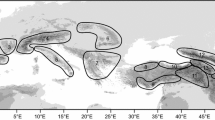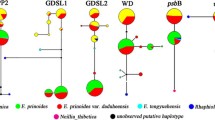Abstract
The identity of plants morphologically intermediate betweenPotamogeton crispus andP. perfoliatus from two recently discovered sites, one in Moravia, Czech Republic and another in Wales, United Kingdom, was investigated with molecular markers. Evidence from restriction fragment length polymorphism analysis of the nuclear internal transcribed spacer region of ribosomal DNA and of thetrnK-trnQ chloroplast DNA intergenic spacer confirmed the morphology-based determination of two putative hybrid samples asP. ×cooperi. The hybrids showed the ITS variants of both parental taxa, consistent with the expected biparental inheritance of nuclear DNA. The chloroplast DNA markers indicateP. crispus as the female parent in both hybridization events. The hybrid origin of another dubious sample was excluded by the molecular data, in accordance with previous detailed morphological examination. This plant represented an extreme, narrow-leaved form ofP. perfoliatus, imitatingP. ×cooperi in some characters. The results of the molecular analyses are discussed in relation to the morphology of the plants. They underline that somePotamogeton hybrids could indeed be identified by careful and detailed morphological examination and also that these identifications were reliable and confirmed by molecular markers. This study exemplifies that long-term taxonomic expertise usually generates very well-founded specific questions suitable for straightforward treatment by appropriate molecular methods. The process and ecological implications of hybrid formation are also discussed
Similar content being viewed by others
References
Ascherson P. &Graebner P. (1897):Synopsis der mitteleuropäischen Flora 1. Wilhelm Engelman, Leipzig.
Álvarez I. &Wendel J.F. (2003): Ribosomal ITS sequences and plant phylogenetic inference.Molec. Phylogenet. Evol. 29: 417–434.
Baagøe J. (1897):Potamogeton undulatusWolfgang.Bot. Tidsskr. 21: 221–236, pl. 7.
Baumel A., Ainouche M.L. &Levasseur J.E. (2001): Molecular investigations in populations ofSpartina anglicaC.E. Hubbard (Poaceae) invading coastal Brittany (France).Molec. Biol. 10: 1689–1701.
Birky C.W. Jr. (1995): Uniparental inheritance of mitochondrial and chloroplast genes: Mechanisms and evolution.Proc. Natl. Acad. Sci. USA 92: 11331–11338.
Campbell C.S., Wojciechowski M.F., Bladwin B.G., Alice L.A. &Donoghue M.J. (1997): Persistent nuclear ribosomal DNA sequence polymorphism in theAmelanchier agamic complex.Molec. Biol. Evol. 14: 81–90.
Dandy J.E. (1975):Potamogeton L. In:Stace C.A. (ed.),Hybridization and the flora of the British Isles, Academic Press, London, pp. 444–459.
Dandy J.E. (1980): 1.Potamogeton L. In:Tutin T.G., Heywood V.H., Burges N.A., Moore D.M., Valentine D.H., Walters S.M. &Webb D.A. (eds.),Flora Europaea 5: Alismataceaeto Orchidaceae (Monocotyledones), Cambridge University Press, Cambridge, pp. 7–11.
Dandy J.E. &Taylor G. (1946): An account of ×Potamogeton suecicusRicht. in Yorkshire and the Tweed.Trans. & Proc. Bot. Soc. Edinburgh 34: 348–360.
Dumolin-Lapegue S., Pemonge M.-H. &Petit R.J. (1997): An enlarged set of consensus primers for the study of organelle DNA in plants.Molec. Ecol. 6: 393–397.
Fant J.B., Preston C.D. &Barrett J.A. (2001a): Isozyme evidence for the origin ofPotamogeton ×sudermanicus as a hybrid betweenP. acutifolius andP. berchtoldii.Aquatic Bot. 71: 199–208.
Fant J.B., Preston C.D. &Barrett J.A. (2001b): Isozyme evidence of the parental origin and possible fertility of the hybridPotamogeton × fluitansRoth.Pl. Syst. Evol. 229: 45–57.
Fant J.B., Kamau E.M. &Preston C.D. (2003): Chloroplast evidence for the multiple origins of the hybridPotamogeton × sudermanicusHagstr.Aquatic Bot. 75: 351–356.
Fischer G. (1904): Beitrag zur Kenntnis der bayerischen Potamogetoneen IV.Mitt. Bayer. Bot. Ges. 1: 356–366 & 375–388.
Fischer G. (1905): Beitrag zur Kenntnis der bayerischen Potamogetoneen V.Mitt. Bayer. Bot. Ges. 1: 471–475.
Fischer G. (1907): Die bayerischen Potamogetonen und Zannichellien.Ber. Bayer. Bot. Ges. 11: 20–162.
Franzke A. &Mummenhoff K. (1999): Recent hybrid speciation inCardamine (Brassicaceae) — conversion of nuclear ribosomal ITS sequences in statu nascendi.Theor. Appl. Genet. 98: 831–834.
Fryer A. (1890): Supposed hybridity inPotamogeton.J. Bot. 28: 173–179.
Fryer A. (1891): On a new BritishPotamogeton of thenitens group.J. Bot. 29: 289–292, t. 313.
Fryer A. (1897):Potamogeton undulatus,Wolf. =P. perfoliatus × crispus.Rep. Bot. Soc. Exch. Club Brit. Isles 1: 497.
Galinis V. (1963):1 šeima. Pludiniai — PotamogetonaceaeEngl. In:Natkevičaitė-IvanauskienėM. (ed.),Lietuvos TSR Flora (Flora of Lithuania) 2, Lietuvos TSR Mokslu Akademija Botanikos Institutas, Vilnius, pp. 35–84 & 677.
Glück H. (1936): Pteridophyten und Phanerogamen. In:Pascher A. (ed.),Süßwasserflora Mitteleuropas 15, Jena.
Graebner P. (1907): 4.Potamogeton (Tourn.) L. In:Engler A. (ed.),Das Pflanzenreich, Regni vegetabilis conspectus 31 (IV. 11), Berlin, pp 39–142 & 161–162.
Hagström J.O. (1916): Critical researches on the Potamogetons.Kungl. Svenska Vetenskapsakad. Handl. 55(5): 1–281.
Hall T.A. (1999): BioEdit: a user-friendly biological sequence alignment editor and analysis program for Windows 95/98/NT.Nucl. Acids Symp. Series 41: 95–98.
Haynes R.R. (1985): A revision of the clasping-leavedPotamogeton (Potamogetonaceae).Sida 11: 173–188.
Haynes R.R. &Hellquist C.B. (2000): 195.PotamogetonaceaeDumortier. In:Flora of North America Editorial Committee (eds.),Flora of North America north of Mexico 22, Oxford University Press, New York, pp. 47–74.
Hejný S. (1950): Čeled’ 138.Potamogetonaceae. Rdestovité — Rudavcovité. In:Dostál. J. (ed.),Květena ČSR (Flora of the Czechoslovakia) 2, ČSBS, Praha, pp. 1722–1737.
Heslop-Harrison J.W. &Clark W.A. (1941): Hybrid Potamogetons on the Isle of Benbecula.Occas. Notes Dept. Bot., King’s Coll., Newcastle upon Tyne 2: 1–4.
Hettiarachchi P. &Triest L. (1991): Isozyme polymorphism in the genusPotamogeton (Potamogetonaceae).Opera Bot. Belg. 4: 87–114.
Hollingsworth P.M., Gornall R.J. &Preston C.D. (1995a): Genetic variability in British populations ofPotamogeton coloratus (Potamogetonaceae).Pl. Syst. Evol. 197: 71–85.
Hollingsworth P.M., Preston C.D. &Gornall R.J. (1995b): Isozyme evidence for hybridization betweenPotamogeton natans andP. nodosus (Potamogetonaceae) in Britain.Bot. J. Linn. Soc. 117: 59–69.
Hollingsworth P.M., Preston C.D. &Gornall R.J. (1996a): Genetic variability in two hydrophilous species ofPotamogeton, P. pectinatus andP. filiformis (Potamogetonaceae).Pl. Syst. Evol. 202: 233–254.
Hollingsworth P.M., Preston C.D. &Gornall R.J. (1996b): Isozyme evidence for the parentage and multiple origins ofPotamogeton ×suecicus (P. pectinatus × P. filiformis, Potamogetonaceae).Pl. Syst. Evol. 202: 219–232.
Hollingsworth P.M., Preston C.D. &Gornall R.J. (1998): Euploid and aneuploid evolution inPotamogeton (Potamogetonaceae): a factual basis for interpretation.Aquatic Bot. 60: 337–358.
Iida S. &Kadono Y. (2002): Genetic diversity and origin ofPotamogeton anguillanus (Potamogetonaceae) in Lake Biwa, Japan.J. Plant Res. 115: 11–16.
Kalkman L. &van Wijk R.J. (1984): On the variation on chromosome number inPotamogeton pectinatus L.Aquatic Bot. 20: 343–349.
Kaplan Z. (2001):Potamogeton × fluitans (P. natans × P. lucens) in the Czech Republic. I. Morphology and anatomy.Preslia 73: 333–340.
Kaplan Z. (2002a): Phenotypic plasticity inPotamogeton (Potamogetonaceae).Folia Geobot. 37: 141–170.
Kaplan Z. (2002b): 147.PotamogetonaceaeDum. — rdestovité. In:KubátK., HroudaL., ChrtekJ. jun.,KaplanZ., KirschnerJ. &ŠtěpánekJ. (eds.),Klíč ke květeně České republiky (Key to the flora of the Czech Republic), Academia, Praha, pp. 736–743.
Kaplan Z. &Štěpánek J. (2003): Genetic variation within and between populations ofPotamogeton pusillus agg.Pl. Syst. Evol. 239: 95–112.
Kaplan Z. &Wolff P. (2004): A morphological, anatomical and isozyme study ofPotamogeton × schreberi: confirmation of its recent occurrence in Germany and first documented record in France.Preslia 76: 141–161.
Kaplan Z., Plačková I. &Štěpánek J. (2002):Potamogeton × fluitans (P. natans × P. lucens) in the Czech Republic. II. Isozyme analysis.Preslia 74: 187–195.
King R.A., Gornall R.J., Preston C.D. &Croft J.M. (2001): Molecular confirmation ofPotamogeton × bottnicus (P. pectinatus × P. vaginatus, Potamogetonaceae) in Britain.Bot. J. Linn. Soc. 135: 67–70.
Les D.H. &Philbrick C.T. (1993): Studies of hybridisation and chromosome number variation angiosperms: evolutionary implications.Aquatic Bot. 44: 181–228.
Nováková H. (1982): Rozšíření vybraných širokolistých rdestů (Potamogeton L.) v ČSR (Distribution of selected broad-leaved pondweeds (Potamogeton L.) in the Czech Republic).Práce Stud., Přír. (Pardubice) 13–14: 49–71.
Ogden E.C. (1943): The broad-leaved species ofPotamogeton of North America north of Mexico.Rhodora 45: 57–105, 119–163 & 171–214.
Ploeg D.T.E. van der (1990): De Nederlandse breedbladige Fonteinkruiden.Wetensch. Meded. Kon. Ned. Natuurhist. Ver. 195: 1–98.
Preston C.D. (1988a): Alfred Fryer and the study of the genusPotamogeton of the British Islcs.Arch. Nat. Hist. 15: 15–33.
Preston C.D. (1988b): ThePotamogeton taxa described by Alfred Fryer.Watsonia 17: 23–35.
Preston C.D. (1995):Pondweeds of Great Britain and Ireland. Botanical Society of the British Isles, London.
Preston C.D. (2001): [review] Flora of North America north of Mexico. Volume 22Magnoliophyta: Alismatidae, Arecidae, Commelinidae (in part), andZingiberaceae.Watsonia 23: 458–459.
Preston C.D., Bailey J.P. &Hollingsworth P.M. (1998a): A reassessment of the hybridPotamogeton × gessnacensisG. Fisch. (P. natans × P. polygonifolius, Potamogetonaceae) in Britain.Watsonia 22: 61–68.
Preston C.D. &Chater A.O. (1997):Potamogeton × cooperi(Fryer) Fryer in Wales.Bot. Soc. Brit. Isles Welsh Bull. 62: 11–12.
Preston C.D. &Croft J.M. (1997):Aquatic plants in Britain and Ireland. Harley Books, Colchester.
Preston C.D., Hollingsworth P.M. &Gornall R.J. (1998b):Potamogeton pectinatus L. ×P. vaginatusTurcz (P. × bottnicusHagstr.), a newly identified hybrid in the British Isles.Watsonia 22: 69–82.
Preston C.D., Hollingsworth P.M. &Gornall R.J. (1999): The distribution and habitat ofPotamogeton × suecicusK. Richt. (P. filiformisPers. ×P. pectinatus L.) in the British Isles.Watsonia 22: 329–342.
Raunkiaer C. (1896):De Danske blomsterplanters naturhistorie (Natural history of Danish flowering plants). I. Helobiae. Kjobenhavn.
Raunkiaer C. (1903): AnatomicalPotamogeton-studies andPotamogeton fluitans.Bot. Tidssk. 25: 253–280.
Štorchová H., Hrdličková R., Chrtek J. Jr.,Tetera M., Fitze D. &Fehrer J. (2000): An improved method of DNA isolation from plants collected in the field and conserved in saturated NaCl/CTAB solution.Taxon 49: 79–84.
Thompson J.D., Gibson T.J., Plewniak F., Jeanmougin F. &Higgins D.G. (1997): The CLUSTAL_X windows interface: flexible strategies for multiple sequence alignment aided by quailty analysis tools.Nucl. Acids Res. 25: 4876–4882.
Topa E. (1966): Fam. 112.PotamogetonaceaeA.L. Juss. In:SąvulescuT. (ed.),Flora republicii socialiste Romania (Flora of Romania) 11, Acad. Reip. Soc. Rom., Bucuresti, pp. 54–88.
van Wijk R.J., van Goor E.M.J. &Verkley J.A.C. (1988): Ecological studies onPotamogeton pectinatus L. II. Autecological characteristics, with emphasis on salt tolerance, intraspecific variation and isoenzyme patterns.Aquatic Bot. 32: 239–260.
Vargas P., McAllister H.A., Morton C., Jury S.L. &Wilkinson M.J. (1999): Polyploid speciation inHedera (Araliaceae): phylogenetic and biogeographic insights based on chromosome counts and ITS sequences.Pl. Syst. Evol. 219: 165–179.
Wendel J.F. (2000): Genome evolution in polyploids.Pl. Molec. Biol. 42: 225–249.
Wendel J.F., Schnabel A. &Seelanan T. (1995): Bidirectional interlocus concerted evolution following allopolyploid speciation in cotton (Gossypium).Proc. Natl. Acad. Sci. USA 92: 280–284.
White T.J., Bruns T., Lee S. &Taylor J. (1990): Amplification and direct sequencing of fungal ribosomal RNA genes for phylogenetic. In:Innis M.A., Gelfand D.H., Sninsky J.J. &White T.J. (eds.),PCR Protocols: A guide to methods and applications, Academic Press, San Diego, pp. 313–322.
Wiegleb G. (1990): The importance of stem anatomical characters for the systematics of the genusPotamogeton L.Flora 184: 197–208.
Wiegleb G. &Kaplan Z. (1998): An account of the species ofPotamogeton L. (Potamogetonaceae).Folia Geobot. 33: 241–316.
Wolfe Murphy S.A., Smith S.J. &Preston C.D. (1991): Irish pondweeds: 1. A recent record ofPotamogeton × cooperi (Fryer)Fryer from Co. Antrim.Irish. Nat. J. 23: 457–458.
Author information
Authors and Affiliations
Corresponding author
Rights and permissions
About this article
Cite this article
Kaplan, Z., Fehrer, J. Evidence for the hybrid origin ofpotamogeton ×cooperi (Potamogetonaceae): Traditional morphology-based taxonomy and molecular techniques in concert. Folia Geobot 39, 431–453 (2004). https://doi.org/10.1007/BF02803212
Received:
Revised:
Accepted:
Issue Date:
DOI: https://doi.org/10.1007/BF02803212




